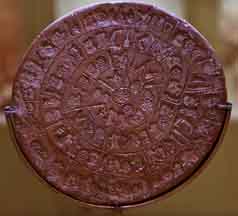Linear A and me
I watched a Secrets of the Dead show on public television last night (you can watch the whole thing "Sinking Atlantis" at: video dot pbs dot org slash video slash 1204753806) and although some interesting points were made I was disappointed in the generally irresponsible thesis that the eruption of the Thera volcano caused the destruction of Minoan civilization (with a not-so-friendly assist from the Achaean Greeks). For reasons which I'll go into in my next post this just isn't correct but my attention was caught by something else.

Phaistos Disk, Heraklion Archaeological Museum. 16-15 century BC. An example of Linear A.
I was stunned to hear Dr. J. Alexander McGillivray (a reputable scholar and who has contributed to the Aerial Atlas of Crete which I own and probably many other things) blandly assert that Linear A had been deciphered.
Nothing could be further from the truth.
For those unfamiliar with this topic I will explain that the term 'Linear A' is reserved for the pictographic symbol system in which the language of the Minoan people was written. Why can't Linear A be deciphered? (And why is it unlikely ever to be deciphered?) Simple. We don't know what language the Minoans used. We don't even know what language family their language belonged to. As long as that's true it will constitute an insurmountable obstacle to translation. For example, when Champollion translated the Rosetta stone and showed us how to read hieroglyphics he had already formulated the hypothesis that the underlying language of the Egyptians was part of the Semitic language family and he had thoroughly prepared himself in Semitic languages. When his tentative phonetic equivalences for the hieroglyphs began to yield semitic-looking words he was ready to take advantage of that fact. Similarly Michael Ventris' real contribution to scholarship was his inspired guess that the underlying language of Linear B was Greek; a language he already knew. When his suggested equivalences for linear B symbols began to yield Greek-looking words he was ready to take advantage of that.
Modern scholars have suggested phonetic equivalences for all the Linear A pictographs. Since they're working backwards from the already known Linear B they're probably largely right in these phonetic guesses. Unfortunately these phonetic equivalences yield words in a language that no one knows. Even if McGillivray is right and that the language of the Minoans is some sort of IE/Persian offshoot (but recent DNA evidence suggests that the Minoan people actually came from upper Mesopotamia) they would have brought their language to Crete in about 3200 BC. Problem. The bulk of the available Linear A documents are from after 2000 BC. This is a gap of at least 1200 years. Do you suppose that languages stand still for 1200 years? I'll bet they don't. 1200 years ago the English language, for example, didn't even exist. The first written evidences for French and German are about 1200 years old (Strasbourg Oaths, in 842) but in forms which their modern speakers would hardly recognize. Most of us have trouble reading a page of Chaucer (about 650 years ago) or Shakespeare (about 500 years ago) and those are in our own language. Michael Ventris translated the Greek of Linear B (mostly written down in the 15th century BC) being able to compare them to forms in Homer (perhaps 600 years later) and even he described the Greek of the Mycenaeans as 'primitive', that is, barely recognizable. That's the real problem with Linear A. Even if we do correctly guess the language of the Minoans it would probably be an isolate: a distant descendant of whatever we know about that language family. For McGillivray to suggest anything else is just irresponsible and, frankly, completely wrong.
When it comes to Linear A many scholars have announced its 'decipherment'. These announcements are undercut by the fact that these decipherments are usually to radically different language systems. It's been variously ascribed to Greek, Luvian, Phoenician, Indo-Iranian, Tyrrhenian, and others. The fact that Linear A can be ascribed to such different language families helps to illustrate the problem. As Jesus says, 'Many are called, but few are chosen.' There's an unfakeable test for the efficacy of any given decipherment. All a scholar has to do is tell us what it says on the Phaistos Disk (no guessing!). But far from being able to tell us what it says scholars can't even tell us what it is ('perhaps a hymn', 'perhaps a board game', 'perhaps a geometric proof'). Nor can they answer the questions we're really interested in. For example why did someone take the trouble to carve punches with the characters on them? For the Phaistos Disk is not inscribed by hand. It was made with punches. Why can't we know this? Well … you already know why; we can't read what they're trying to say to us.
I've said that we'll never decipher Linear A. Is that true?
In the novel Thirteen at Dinner Agatha Christie records this conversation between Hastings and her detective hero Hercule Poirot. With regard to some knotty problem Hastings says (I'm quoting from memory) 'We'll never know.' To this Poirot fiercely replies, 'We can know. We will know. The power of the human brain, Hastings, is almost unlimited.'
I don't think Linear A can be deciphered but for those who work on it: bon chance!



















